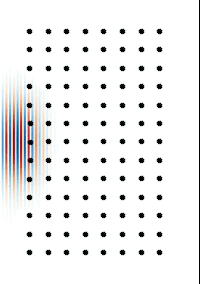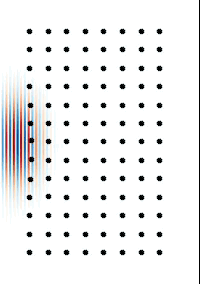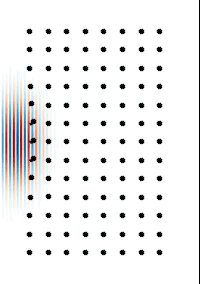When an intense laser pulse passes through a plasma, the strong electro-magnetic fields act to expel charged particles from the regions with the highest laser intensity. This is known as the ponderomotive force and accelerates mainly the electrons in the plasma, due to their much lower mass relative to the positive ions. This creates a charge displacement electrostatic field, which pulls the electrons back towards the regions of net positive charge. After the laser pulse has left, the electrons continue to oscillate around their equilibrium positions.
This is illustrated in the animations below, which are created by tracking the positions of some ‘test’ electrons (black balls) in a computer simulation as a laser pulse (red and blue) passes through. The stronger the laser pulse, the stronger the oscillations, leading to very chaotic behaviour for very relativistic pulses. The movies below show the electron motion for a laser pulse of increasing strength (a0 = 1, 2 and 4) propagating through a low density plasma.



The phase velocity of plasma wave is equal to the group velocity of the driver. This means that the plasma wave looks static from the point of view of the laser pulse. As the laser pulse moves very close to the speed of light, a relativistic particle, injected behind the laser pulse can become trapped in the accelerating region of the plasma wave, gaining energy for as long as it is trapped. In this way you can make an accelerating structure, which is conceptually similar to radio-frequency accelerating cavities used in large particle accelerators. However, the accelerating field strength is typically 1000 times greater than you can achieve with cavity based accelerators. If we can match the other properties of these accelerators such as beam quality, stability and repetition rate then plasma wakefield accelerators would takeover the world!! (in a limited way and only in the field of particle acceleration)
